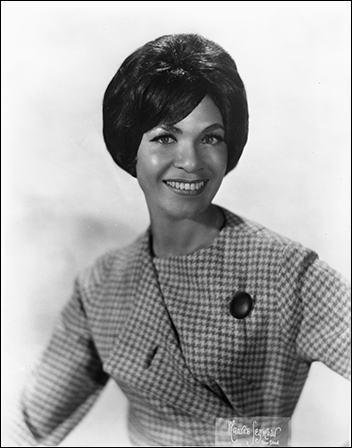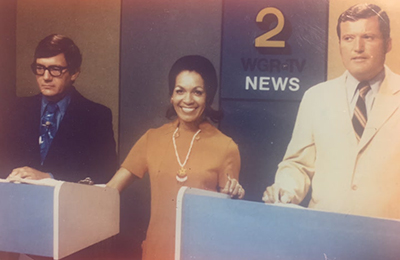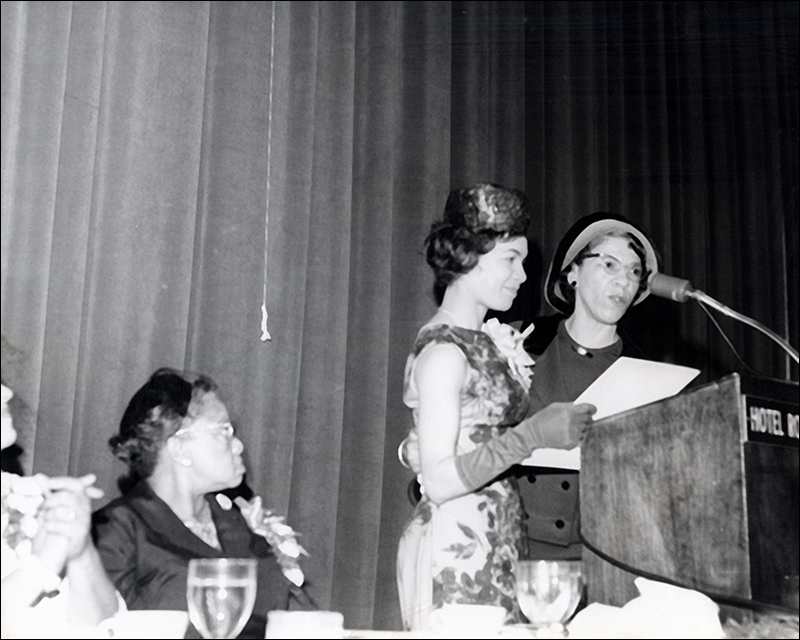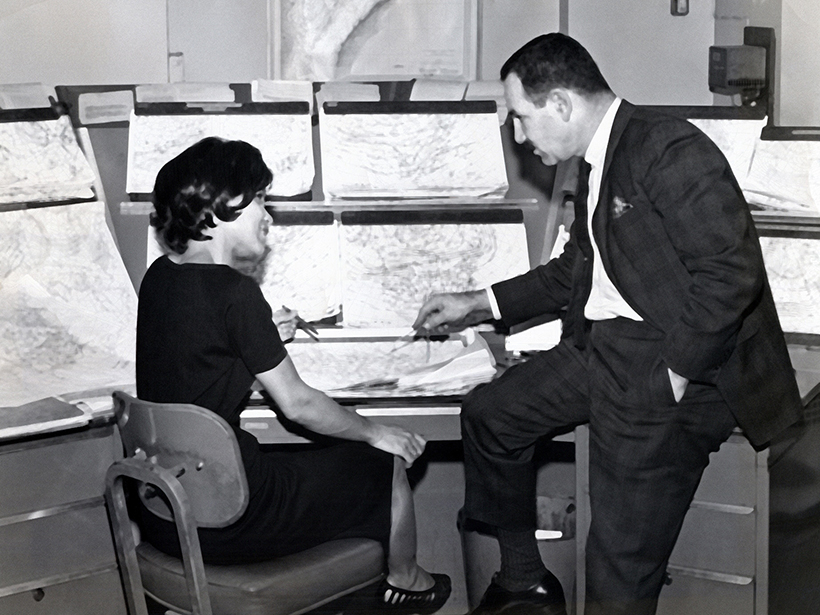June Bacon-Bercey, a pioneering meteorologist and passionate supporter of women and minorities in the sciences, was well versed in high-pressure fronts and absolute humidity. But it was her knowledge of the composer John Philip Sousa that catapulted her into the public eye in 1977 when she won $64,000 on a well-known television quiz show. Bacon-Bercey, who used part of her winnings to endow an AGU scholarship for women studying atmospheric sciences, passed away in July 2019 at the age of 90 from frontotemporal dementia.
Bacon-Bercey (née Griffin) grew up in Wichita, Kan., in the heart of Tornado Alley. The weather, stars, and planets all captivated the young Bacon-Bercey, said her daughter, Dail St. Claire. “She always called herself a nerd and a bookworm. She always asked why.”
There were no professional scientists in Bacon-Bercey’s immediate family, but she was surrounded by successful women. Her aunt Bessie, for example, was an entrepreneur who opened the first Black-owned beauty supply school in Wichita.
After graduating from high school, Bacon-Bercey stayed close to home: She attended Friends University, a private university in Wichita, where she majored in math. But she left after 2 years. “She knew she wanted to be a meteorologist,” said St. Claire. “She wanted to get a degree in meteorology.”
Proving Herself
Bacon-Bercey headed west, to the University of California, Los Angeles (UCLA), one of the few schools at the time to offer a 4-year degree in the atmospheric sciences.
She threw herself into her studies but found that she had to constantly prove herself—some people doubted her abilities simply because she was a woman. “When I chose my major, my adviser, who is still at UCLA, advised me to go into home economics,” she told the Baltimore Sun in 1977.

Bacon-Bercey got the last word, however. She earned an undergraduate degree in meteorology in 1954, the first African American woman to be conferred that degree from UCLA. (More than 2 decades later, Bacon-Bercey returned to school to earn a master of public administration from the University of Southern California.)
Shortly after graduating, Bacon-Bercey moved to Washington, D.C., and joined the National Oceanic and Atmospheric Administration’s (NOAA) National Weather Service as a weather analyst and forecaster.
But her varied interests soon led her on a different path: Bacon-Bercey wanted to better understand the effects of hydrogen and atomic bombs on Earth’s atmosphere. Atomic bombs had devastated the Japanese cities of Hiroshima and Nagasaki just a decade earlier, and Castle Bravo, the United States’ largest nuclear detonation, had been carried out at Bikini Atoll in the Marshall Islands while Bacon-Bercey was finishing her undergraduate degree. In 1959, Bacon-Bercey accepted a position at the Atomic Energy Commission as a senior adviser.
“She was always an advocate for the environment,” said St. Claire.
Television: A New Challenge
In the early 1960s, Bacon-Bercey rejoined the National Weather Service in its New York City offices as a radar meteorologist. By the end of the decade, however, a new opportunity had presented itself: a job opening for a TV meteorologist at WRC-TV in Washington, D.C. Bacon-Bercey was initially hesitant to appear on the air. “I did not want to do weather on television, only because at that time I felt it was still gimmicky for women, and I didn’t want to prostitute my profession by being some kind of clown,” Bacon-Bercey told Robert Henson in his book Weather on the Air: A History of Broadcast Meteorology.
But Bacon-Bercey eventually agreed to pursue the television opportunity, relishing the challenge of something new. The following year, she became chief meteorologist at WGR-TV in Buffalo, N.Y.

“She was what we’d call a science reporter today,” said Steve Cichon, a Buffalo broadcasting historian. But in the 1970s, she was considered just another “weather girl,” a pretty face presenting the forecast. Although viewers didn’t know that she had a degree in meteorology, her training didn’t go unnoticed by her peers.
In December 1972, Bacon-Bercey was recognized by the American Meteorological Society (AMS) with its Seal of Approval, which honored “on-air meteorologists for their sound delivery of weather information to the general public.” Bacon-Bercey was the 96th awardee for television since the prize’s inception in 1957 and the first female winner.
Bacon-Bercey’s work ethic was reflected in that honor and others that followed.
“She did everything 110%,” said St. Claire, adding that her mother had to forge her own way. “She couldn’t see [anyone who] looked like her. There wasn’t a lot of support.”
Encouraging Young Scientists
Bacon-Bercey was passionate about promoting the careers of women and minority researchers working in the atmospheric sciences—perhaps she saw her efforts as a way of lessening the burdens of those who followed in her footsteps.
In 1974, Bacon-Bercey served on two committees that would merge to become the American Meteorological Society’s Board on Women and Minorities. Along with 11 other founding members, she brainstormed how to encourage and support scientists from underrepresented groups as they pursued careers in the atmospheric sciences.

Peggy LeMone, an atmospheric scientist at the National Center for Atmospheric Research in Boulder, Colo., who worked with Bacon-Bercey on the Board on Women and Minorities, remembers the meteorologist as upbeat and proactive. “She was full of ideas.”
Warren M. Washington, an atmospheric scientist and another one of the founding members of the Board on Women and Minorities, remembers Bacon-Bercey as being driven and outspoken, someone unafraid to share her opinions. “She was a strong lady,” he said. Bacon-Bercey broke into a field dominated by men, Washington said, but that came with a price. “She felt at times that she wasn’t getting sufficient recognition for her achievements.”
The Board on Women and Minorities organized its first session at the AMS Annual Meeting in Denver in January 1975. As part of that session, which was standing-room only, Bacon-Bercey memorably appeared in a skit meant to highlight issues faced by women. An eager meteorology student, played by Bacon-Bercey, was peppered with sexist questions by her academic adviser, played by AMS president-elect Charles Hosler. Bacon-Bercey had to field questions about being a woman boss and balancing her work with her duties as a wife and mother, queries that seemed absurd when Bacon-Bercey and Hosler switched roles.
Science fairs “serve as a natural breeding ground for budding scientists” and “as a continual source of female and minority science-minded students.”
Bacon-Bercey took on many responsibilities as a member of the AMS Board on Women and Minorities. One she was particularly passionate about was the science fair judging program, which she established in 1976. Bacon-Bercey spearheaded an effort to connect members of the AMS’s 87 active chapters with science fairs for elementary school– and high school–aged students. American Meteorological Society members—practicing meteorologists, university personnel, and National Weather Service staff alike—volunteered their time to judge the fairs’ atmospheric science–related entries. The work was intended to further the outreach efforts of the Board on Women and Minorities and to attract young adults interested in a scientific career.
“Too often girls and minorities get discouraged early in high school from pursuing a career in the atmospheric sciences,” Bacon-Bercey wrote in the August 1976 issue of the Bulletin of the American Meteorological Society. Science fairs “serve as a natural breeding ground for budding scientists” and “as a continual source of female and minority science-minded students,” she noted.
During the program’s first year, hundreds of judges volunteered at 190 science fairs across the country. Despite requiring significant logistical coordination, the program was an effective way of identifying promising young women and minority students—the Board on Women and Minorities made sure to send the winners information about a career in atmospheric science.
Bacon-Bercey, true to form, had no shortage of additional ideas about supporting scientists-in-training from underrepresented groups. She served on the board of directors of the National Consortium for Black Professional Development. She was a highly sought-after speaker for events such as the Black Consortium Science Competition. She volunteered her time at Jackson State University, a historically Black university in Mississippi, to help set up a meteorology lab there.
Establishing a Scholastic Legacy
But there was something else Bacon-Bercey wanted to do, and it would require funding.
Luckily, Bacon-Bercey came into a windfall in 1977 when she appeared on the television quiz show The $128,000 Question. Thanks to her knowledge of esoteric facts about the composer John Philip Sousa—for example, “What 1890 descriptive piece by Sousa was partially inspired by a section of a best-selling 1880 novel?”—she took home $64,000. (The answer is “The Chariot Race,” inspired by Ben Hur.) St. Claire remembers her mother studying for the game show for hours on end with cue cards. “When my mother pursued something, it was not a casual event,” said St. Claire.
Bacon-Bercey was not at a loss for what to do with her winnings—she’d had something in mind for a long time: a scholarship to support women interested in meteorology. “That was my plan at the beginning, and it’s still my plan,” Bacon-Bercey told the Washington Post in 1977. She hoped to smooth the way for other women following in her footsteps. “I was discouraged [from becoming a meteorologist], and other women were discouraged. If they feel they’ve got some money behind them, it might be better,” she told the Post.
Working with AGU, she established the June Bacon-Bercey Scholarship in Atmospheric Sciences for Women. Applications from undergraduate and graduate students were solicited; the primary criterion was a demonstration of coursework leading to a degree in the atmospheric sciences. The scholarship was initially $400 and was later increased to $500.
The inaugural winner, in 1978, was Anthea J. Coster, then a second-year graduate student in the space physics and astronomy program at Rice University in Houston, Texas. Today Coster is a space physicist and an assistant director of Massachusetts Institute of Technology’s Haystack Observatory in Westford. Her research interests are diverse: atmospheric corrections for satellite tracking, GPS measurements, the physics of Earth’s atmosphere, and space weather, among others.
After a 3-decade hiatus, the scholarship will resume in 2021, as per Bacon-Bercey’s wishes.
Coster remembers the scholarship helping her buy such textbooks as Digital Signal Processing by Alan V. Oppenheim and Ronald W. Schafer and Astrophysical Concepts by Martin Harwit. “Books are very, very expensive,” she said. “I was very grateful to have that money.”
She regrets never getting a chance to meet the woman who endowed her scholarship, something she credits with making a “huge difference” in her career. “It really gave me a boost.”
From 1979 to 1990, 12 other young women—11 graduate students and one undergraduate—won the scholarship. It ceased being offered in 1990, but after a 3-decade hiatus, the scholarship will resume in 2021, with an award of $1,000, as per Bacon-Bercey’s wishes. “Her final wish was to have it be reinstated,” said St. Claire.
A New Passion: Teaching
After serving as a public affairs specialist for NOAA in Washington, D.C., Bacon-Bercey moved to the San Francisco Bay Area. She never really retired, said St. Claire. At the age of 59, she earned a teaching credential so she could teach elementary and high school math and science courses. “I love the teaching,” Bacon-Bercey told the San Francisco Chronicle’s SFGate in 2000. “It nurtures me, and some of the kids just blow me away with what they know.” Bacon-Bercey continued to teach well into her eighties.
In 2006, Bacon-Bercey was the subject of a children’s book by Ann Weil titled June Bacon-Bercey: A Meteorologist Talks About the Weather. Aimed at beginning readers, the book introduces young people to Bacon-Bercey’s work. (“She studied where it was hot or cold. She measured the speed of the wind.”)

Bacon-Bercey influenced so many people, said her daughter. From young scientists who learned about meteorology through a science fair project to the past and future winners of her AGU scholarship to the students she taught in California, her sphere of influence was enormous. Later in life, the recognition that Bacon-Bercey craved poured in—St. Claire admits she’s just now getting around to going through her mother’s numerous honors.
“There are boxes and boxes of awards,” she said. But more important is the path that Bacon-Bercey carved for others to follow, St. Claire said. “She changed the face of meteorology.”
—Katherine Kornei (@KatherineKornei), Science Writer
Citation:
Kornei, K. (2020), June Bacon-Bercey: Pioneering meteorologist and passionate supporter of science, Eos, 101, https://doi.org/10.1029/2020EO140183. Published on 17 February 2020.
Text © 2020. The authors. CC BY-NC-ND 3.0
Except where otherwise noted, images are subject to copyright. Any reuse without express permission from the copyright owner is prohibited.

